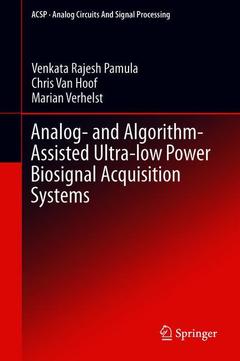Description
Analog-and-Algorithm-Assisted Ultra-low Power Biosignal Acquisition Systems, 1st ed. 2019
Analog Circuits and Signal Processing Series
Language: English
Subjects for Analog-and-Algorithm-Assisted Ultra-low Power Biosignal...:
Support: Print on demand
Description
/li>Contents
/li>Biography
/li>Comment
/li>
- First book to present the so called, ?analog-and-algorithm-assisted? approaches for ultra-low power biosignal acquisition and processing platforms;
- Covers the recent trend of ?beyond Nyquist rate? signal acquisition and processing in detail, including adaptive sampling and compressive sampling paradigms;
- Includes chapters on compressed domain feature extraction, as well as acquisition of photoplethysmogram, an emerging optical sensing modality, including compressive sampling based PPG readout with embedded feature extraction;
- Discusses emerging trends in sensor fusion for improving the signal integrity, as well as lowering the power consumption of biosignal acquisition systems.
Venkata Rajesh Pamula received in BTech in electrical engineering in 2007 from the Indian Institute of Technology and Master of science from Imperial College London in 2010. He worked in various capacities with the Samsung Semiconductors between 2007-09 and 2010-12 before starting to work towards his PhD at KU Leuven in association with imec Belgium. He is currently a visiting scientist with the department of electrical engineering, University of Washington Seattle. His major areas of research are ultra low power sensor readouts, energy efficient mixed signal circuits and systems.
Mr. Pamula is a recipient of the Government of Andhra Pradesh Gold Medal in 2003, ISSCC analog devices outstanding student designer award in 2016 and also received four gold medals from IIT in 2007 for outstanding academic performance.
Chris Van Hoof is Senior Director of Connected Health Solutions at imec in Leuven, Belgium and Eindhoven, the Netherlands and imec Fellow. He is also full professor (part-time) in the Electrical Engineering Department of KU Leuven. After a PhD in Electrical Engineering (University of Leuven, 1992), Chris Van Hoof has held positions at imec at manager and director level in diverse technical fields (sensors and imagers, MEMS and autonomous microsystems, wireless sensors, patient monitoring solutions, medical devices, behavioral technology). He has published over 700 papers in journals and conference proceedings in those fields and has given over 100 invited talks. His R&D has resulted in 5 startups (4 in the healthcare domain) and he has delivered flight hardware to 2 European Space Agency missions.
Prof. Dr. ir. Marian Verhelst is a professor at the MICAS laboratories (MICro-electronics And Sensors) of the Electrical Engineering Department of KU Leuven. Her research focuses on embedded machine learning, energy-efficient hardware accelerators, self-adaptive circuits
First book to present the so called, “analog- and algorithm-assisted” approaches for ultra-low power biosignal acquisition and processing platforms
Covers the recent trend of “beyond Nyquist rate” signal acquisition and processing in detail, including adaptive sampling and compressive sampling paradigms
Includes chapters on compressed domain feature extraction, as well as acquisition of photoplethysmogram, an emerging optical sensing modality, including compressive sampling based PPG readout with embedded feature extraction
Discusses emerging trends in sensor fusion for improving the signal integrity, as well as lowering the power consumption of biosignal acquisition systems




